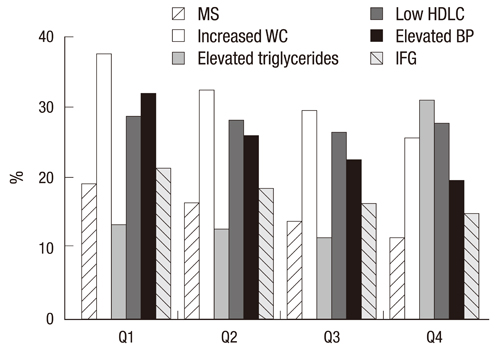J Korean Med Sci.
2011 Oct;26(10):1328-1332. 10.3346/jkms.2011.26.10.1328.
Serum CA125 Concentration has Inverse Correlation with Metabolic Syndrome
- Affiliations
-
- 1Department of Family Practice and Community Health, Ajou University School of Medicine, Suwon, Korea.
- 2Department of Family Medicine, The Catholic University of Korea, Seoul, Korea. kskim@catholic.ac.kr
- KMID: 1785991
- DOI: http://doi.org/10.3346/jkms.2011.26.10.1328
Abstract
- Serum carbohydrate antigen 125 (CA-125) is a marker of ovarian cancer and obesity that is related with an increased risk of ovarian cancer. Obesity is a key factor of metabolic syndrome. We evaluated the relationship between CA-125 concentration and metabolic syndrome. The data from subjects who had any cancer and chronic infection were excluded. The data of 12,196 healthy Korean women were analyzed. After CA-125 concentration was divided by quartiles, the prevalence of metabolic syndrome and its components were compared. The lowest quartile of CA-125 compared with the highest quartile showed elevated values of most of metabolic parameters. In addition, as the quartile of CA-125 increased, metabolic derangement decreased. Increased numbers of metabolic syndrome components showed an inverse association with CA-125 levels (P < 0.001). The odds ratio (OR) for the lowest CA-125 quartile vs the highest CA-125 quartile significantly increased in the presence of metabolic syndrome (OR = 1.202, 95% Confidence Interval [CI] 1.013-1.423), elevated triglyceride (OR = 1.381, 95% CI 1.167-1.633), and low high-density lipoprotein cholesterol (OR = 1.168, 95% CI 1.039-1.312). The presence of metabolic syndrome, elevated triglyceride, or low high-density lipoprotein cholesterol negatively correlates with CA-125 concentration.
Keyword
MeSH Terms
Figure
Reference
-
1. Bast RC Jr, Xu FJ, Yu YH, Barnhill S, Zhang Z, Mills GB. CA 125: the past and the future. Int J Biol Markers. 1998. 13:179–187.2. Verheijen RH, von Mensdorff-Pouilly S, van Kamp GJ, Kenemans P. CA 125: fundamental and clinical aspects. Semin Cancer Biol. 1999. 9:117–124.3. Johnson CC, Kessel B, Riley TL, Ragard LR, Williams CR, Xu JL, Byus SS. Prostate, Lung, Colorectal and Ovarian Cancer Project Team. The epidemiology of CA-125 in women without evidence of ovarian cancer in the Prostate, Lung, Colorectal and ovarian cancer (PLCO) Screening Trial. Gynecol Oncol. 2008. 110:383–389.4. Reaven GM. Banting lecture 1988. Role of insulin resistance in human disease. Diabetes. 1988. 37:1595–1607.5. Laaksonen DE, Lakka HM, Niskanen LK, Kaplan GA, Salonen JT, Lakka TA. Metabolic syndrome and development of diabetes mellitus: application and validation of recently suggested definitions of the metabolic syndrome in a prospective cohort study. Am J Epidemiol. 2002. 156:1070–1077.6. Furberg AS, Veierød MB, Wilsgaard T, Bernstein L, Thune I. Serum high-density lipoprotein cholesterol, metabolic profile, and breast cancer risk. J Natl Cancer Inst. 2004. 96:1152–1160.7. Colangelo LA, Gapstur SM, Gann PH, Dyer AR, Liu K. Colorectal cancer mortality and factors related to the insulin resistance syndrome. Cancer Epidemiol Biomarkers Prev. 2002. 11:385–391.8. Michaud DS, Liu S, Giovannucci E, Willett WC, Colditz GA, Fuchs CS. Dietary sugar, glycemic load, and pancreatic cancer risk in a prospective study. J Natl Cancer Inst. 2002. 94:1293–1300.9. Olsen CM, Green AC, Whiteman DC, Sadeghi S, Kolahdooz F, Webb PM. Obesity and the risk of epithelial ovarian cancer: a systemic review and mea-analysis. Eur J Cancer. 2007. 43:690–709.10. Bray F, Dos Santos Silva I, Moller H, Weiderpass E. Endometrial cancer incidence trends in Europe: underlying determinants and prospects for prevention. Cancer Epidemiol Biomarkers Prev. 2005. 14:1132–1142.11. Alberti KG, Zimmet P, Shaw J. IDF Epidemiology Task Forcd Consensus Group. The metabolic syndrome: a new worldwide definition. Lancet. 2005. 366:1059–1062.12. Kim MH, Kim MK, Choi BY, Shin YJ. Prevalence of the metabolic syndrome and its association with cardiovascular diseases in Korea. J Korean Med Sci. 2004. 19:195–201.13. Ryu SY, Kweon SS, Park HC, Shin JH, Rhee JA. Obesity and the metabolic syndrome in Korean adolescents. J Korean Med Sci. 2007. 22:513–517.14. Wolk A, Gridley G, Svensson M, Nyrén O, McLaughlin JK, Fraumeni JF, Adam HO. A prospective study of obesity and cancer risk (Sweden). Cancer Causes Control. 2001. 12:13–21.15. McLemore MR, Miaskowski C, Aouizerat BE, Chen LM, Dodd MJ. Epidemiological and genetic factors associated with ovarian cancer. Cancer Nurs. 2009. 32:281–288.16. Rodriguez C, Calle EE, Fakhrabadi-Shokoohi D, Jacobs EJ, Thun MJ. Body mass index, height, and the risk of ovarian cancer mortality in a prospective cohort of postmenopausal women. Cancer Epidemiol Biomarkers Prev. 2002. 11:822–828.17. Runnebaum IB, Stickeler E. Epidemiological and molecular aspects of ovarian cancer risk. J Cancer Res Clin Oncol. 2001. 127:73–79.18. Nagle CM, Olsen CM, Webb PM, Jordan SJ, Whiteman DC, Green AC. Australian Cancer Study Group. Australian Ovarian Cancer Study Group. Endometrioid and clear cell ovarian cancers: a comparative analysis of risk factors. Eur J Cancer. 2008. 44:2477–2484.19. Olsen CM, Nagle CM, Whiteman DC, Purdie DM, Green AC, Webb PM. Australian Cancer Study (Ovarian Cancer) and Australian Ovarian Cancer Study Group. Body size and risk of epithelial ovarian and related cancers: a population-based case-control study. Int J Cancer. 2008. 123:450–456.20. Reeves GK, Pirie K, Beral V, Green J, Spencer E, Bull D. Million Women Study Collaboration. Cancer incidence and mortality in relation to body mass index in the Million Women Study: cohort study. BMJ. 2007. 335:1134.21. Tania M, Khan MA, Song Y. Association of lipid metabolism with ovarian cancer. Curr Oncol. 2010. 17:6–11.22. Vollmer RT, Humphrey PA. Tumor volume in prostate cancer and serum prostate-specific antigen. Analysis from a kinetic viewpoint. Am J Clin Pathol. 2003. 119:80–89.23. Sarandakou A, Protonotariou E, Rizos D. Tumor markers in biological fluids associated with pregnancy. Crit Rev Clin Lab Sci. 2007. 44:151–178.
- Full Text Links
- Actions
-
Cited
- CITED
-
- Close
- Share
- Similar articles
-
- Meigs' syndrome with elevated serum CA125 level
- The Correlation of Serum Level of Tumor Marker CA125 and CA19-9 and Severity of Endometriosis
- Validity of serum CA125 level for assessing responsiveness to combined chemotherapy in epithelial ovarian cancer
- Cancer Antigen 125(CA125) as a Bulk Mass Marker of Peritoneal Mesothelial Cell in CAPD Patients
- The Relationship between Plasma Visfatin Level, Obesity and Metabolic Syndrome in Women Without Diabetes



